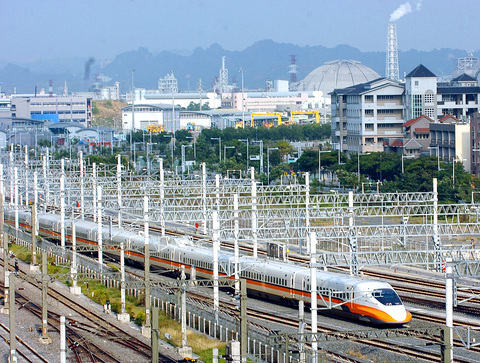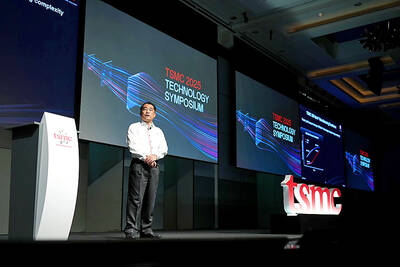Despite lingering questions about the safety of the high speed rail, the Ministry of Transportation and Communications (MOTC) last night approved its official operation.
"In our meeting today, we have confirmed that the Taiwan High Speed Rail Corp [THSRC] has fulfilled each and every requirement of inspectors," said ministry Vice Minister Ho Nuan-hsuen (
"Based on the evaluation of the Lloyd's Register Project Team and the three Japanese consultants, inspection results and relevant railway regulations, the ministry will approve THSRC to begin operations as soon as possible," Ho said, adding that the company needs to make public the ticket prices for at least a week before any operations could begin.

PHOTO: HUANG CHIH-YUAN, TAIPEI TIMES
For the time being, the train will only be allowed to service the line between Banciao and Tsoying.
Yin Chen-pong (
When contacted by the Taipei Times last night, a THSRC official said the firm would launch test operations during the three-day holiday beginning Jan. 1, at discount ticket prices.
The test run would last one week at least before THSRC starts to run the nation's first bullet train officially, THSRC spokesman Arthur Chiang (江金山) said in a phone interview.
"We have fixed all the problems found by the MOTC and the review committee, so we will finally receive the go-ahead ... But, at this point, we cannot set a date for the formal launch yet," Chiang said.
THSRC declined to give details about its proposed ticket prices, but local media reports have said the ticket for the longest trip, a journey of 80 minutes between Taipei and Kaohsiung, may cost NT$1,280.
The price would be 50 percent higher than the train ticket price for the same destination, but 33 percent lower than a flight.
The ministry's announcement came after it held a final review meeting on the high speed rail. Last month, the company was required to perform accident-free test runs for at least one month. The test runs were concluded yesterday.
The press conference last night was attended by MOTC officials and representatives from China Engineering Consultants Inc.
Tsuei Bo-yi (崔伯義), CECI's chief project manager, said yesterday that the firm had recruited Masao Saito, Takeshi Osawa and Jiro Ishimura to help monitor the test runs. Tsuei said that experts had concluded that THSRC's maintenance and traffic control performance had reached operational standards set by Japan's Shinkansen system.
Tsuei further said that the two mishaps that happened on Dec. 5 and Dec. 8 this month could only be considered as "minor operation obstacles" under Japan's railway standards, and as the incidents had not hindered the operations of the main railway line, they could not be viewed as "accidents."
For some inspectors, however, the unconditional approval was a disappointment.

DEMOGRAPHICS: Robotics is the most promising answer to looming labor woes, the long-term care system and national contingency response, an official said Taiwan is to launch a five-year plan to boost the robotics industry in a bid to address labor shortages stemming from a declining and aging population, the Executive Yuan said yesterday. The government approved the initiative, dubbed the Smart Robotics Industry Promotion Plan, via executive order, senior officials told a post-Cabinet meeting news conference in Taipei. Taiwan’s population decline would strain the economy and the nation’s ability to care for vulnerable and elderly people, said Peter Hong (洪樂文), who heads the National Science and Technology Council’s (NSTC) Department of Engineering and Technologies. Projections show that the proportion of Taiwanese 65 or older would

Nvidia Corp yesterday unveiled its new high-speed interconnect technology, NVLink Fusion, with Taiwanese application-specific IC (ASIC) designers Alchip Technologies Ltd (世芯) and MediaTek Inc (聯發科) among the first to adopt the technology to help build semi-custom artificial intelligence (AI) infrastructure for hyperscalers. Nvidia has opened its technology to outside users, as hyperscalers and cloud service providers are building their own cost-effective AI chips, or accelerators, used in AI servers by leveraging ASIC firms’ designing capabilities to reduce their dependence on Nvidia. Previously, NVLink technology was only available for Nvidia’s own AI platform. “NVLink Fusion opens Nvidia’s AI platform and rich ecosystem for

Taiwan Semiconductor Manufacturing Co (TSMC, 台積電) yesterday said it is building nine new advanced wafer manufacturing and packaging factories this year, accelerating its expansion amid strong demand for high-performance computing (HPC) and artificial intelligence (AI) applications. The chipmaker built on average five factories per year from 2021 to last year and three from 2017 to 2020, TSMC vice president of advanced technology and mask engineering T.S. Chang (張宗生) said at the company’s annual technology symposium in Hsinchu City. “We are quickening our pace even faster in 2025. We plan to build nine new factories, including eight wafer fabrication plants and one advanced

‘WORLD’S LOSS’: Taiwan’s exclusion robs the world of the benefits it could get from one of the foremost practitioners of disease prevention and public health, Minister Chiu said Taiwan should be allowed to join the World Health Assembly (WHA) as an irreplaceable contributor to global health and disease prevention efforts, Minister of Foreign Affairs Lin Chia-lung (林佳龍) said yesterday. He made the comment at a news conference in Taipei, hours before a Taiwanese delegation was to depart for Geneva, Switzerland, seeking to meet with foreign representatives for a bilateral meeting on the sidelines of the WHA, the WHO’s annual decisionmaking meeting, which would be held from Monday next week to May 27. As of yesterday, Taiwan had yet to receive an invitation. Taiwan has much to offer to the international community’s